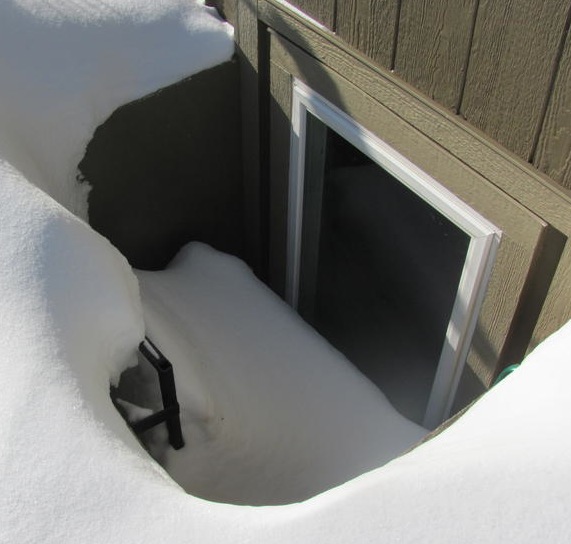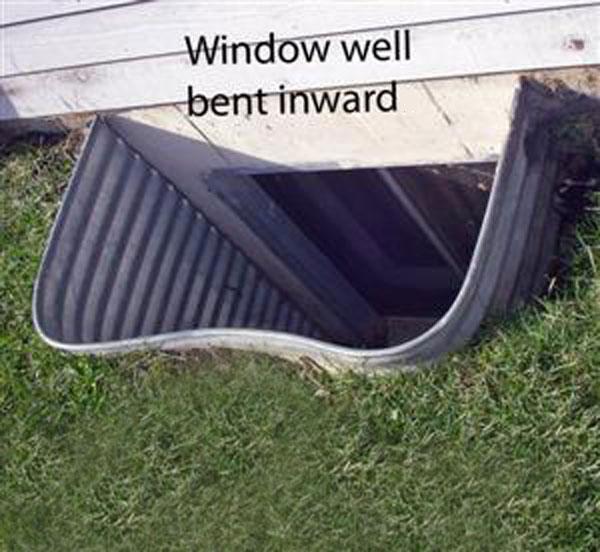Window Well Inspection
- emergency egress. If the window serves a living area -- as opposed to an unfinished basement with exposed utilities (see our article on Non-Conforming Bedrooms) -- emergency escape at a minimum of two locations is required. Window wells allow windows to be used by escaping occupants and emergency crews attempting to enter the house;
- to prevent moisture damage to basement windows that are at or below grade. The window wells keep the soil away from openings in the foundation walls while still allowing proper grading and drainage away from the house; and
- to allow sunlight into a below-grade room that would otherwise require artificial lighting.
Window Well Covers
Window wells are often covered to prevent injuries and falls, as well as to discourage small children,pets and wild animals from entering the wells and becoming injured and trapped. For instance, a deer fawn made news in Bountiful, Utah, after it was recovered safely after falling down a 12-foot-deep uncovered window well. Although not required, window well covers are especially important if the space around the ground level opening is along a walkway or near a children’s play area.
Regarding their strength
and operability, the 2007 edition of the International Code Council (ICC),
Section 3.4, states that window well covers shall support “a minimum live
load of 40 pounds per square foot. The cover shall be operable from within the
window well without the use of tools or special knowledge, and shall require no
more than 30 pounds of force to fully open.” These requirements ensure that an average-size adult would be able to pass through the window well safely during an emergency evacuation.

Covers (like the ones pictured above and built by the author out of polycarbonate sheets and Unistrut®) also prevent the accumulation of twigs, grass, mulch and blowing snow that would obscure sunlight and complicate emergency escape through the well. Covers may be locked from the inside to prevent unwanted intrusion. However, locks and fasteners must be fully functional to be certain that the cover can be easily lifted from the inside.

Window well covers, however, can block sunlight, ventilation and emergency egress, especially if they become covered in snow and ice. It is the homeowner’s responsibility to make sure that the cover is cleared of snow and has not been frozen shut from ice. No items, such as garden hoses, potted plants or tools, should be placed on top of window well covers. Note that covers that are locked from the inside to prevent unlawful entry will be inaccessible to fire crews and first responders.
- size. According to the 2006 edition of the International Residential Code (IRC), Section R310:
The minimum horizontal area of the window well shall be 9 square feet, with a minimum horizontal projection and width of 36 inches.
Even if the well seems large enough for members of a particular household, it might be a tight fit for a fully equipped firefighter; - structural damage to the barrier. Hydrostatic pressure and freeze-thaw cycles can exert a great deal of pressure on window wells and, over time, cause masonry to bend or crack. Check for:
- spalling, bowing, cracking or leaning in concrete;

- cracking or bowing in plastic;
- rust, bowing or rupture in metal; and
- insect damage or cracks in wood.
- spalling, bowing, cracking or leaning in concrete;
- improper drainage. Waterlogged window wells can easily leak through a window into the basement, especially following a heavy rain. Water intrusion can cause a variety of undesirable conditions, such as mold growth, wood decay, corrosion and insect damage. Check for a lack of sufficient cleaning and maintenance both in the window well and elsewhere. Homeowners should first make sure that gutters and downspouts are clear of debris, which can force water to overflow from the gutters and collect in the window well and other low areas. Dirt and debris should also be collected from the well. A qualified professional may be required to correct structural sources of drainage issues, such as soil erosion, insufficient or settled drainage stone, or the pulling away from the foundation of the barrier; and
- lack of a ladder. The 2006 IRC, Section 310.2, states:
Window wells with a vertical depth greater than 44 inches shall be equipped with a permanently affixed ladder or steps usable with the window in the fully open position.
Additional Tips for Homeowners
- Window well covers can be screened or barred to provide pest-free ventilation.
- Teach children to avoid window wells, even if they are covered and appear sturdy.
- Practice exiting the window, window well and window cover so that any previously unnoticed obstacles can be removed. Repair or replace any equipment that does not function properly.
- Speak with your local building department if you are unsure whether a window well is required in your home. Your jurisdiction may mandate special size restrictions.
- Metal window wells can have rolled edges for safety against cuts.
- Consult with your InterNACHI® inspector if you have additional concerns surrounding window wells, covers, moisture problems and emergency egress.

